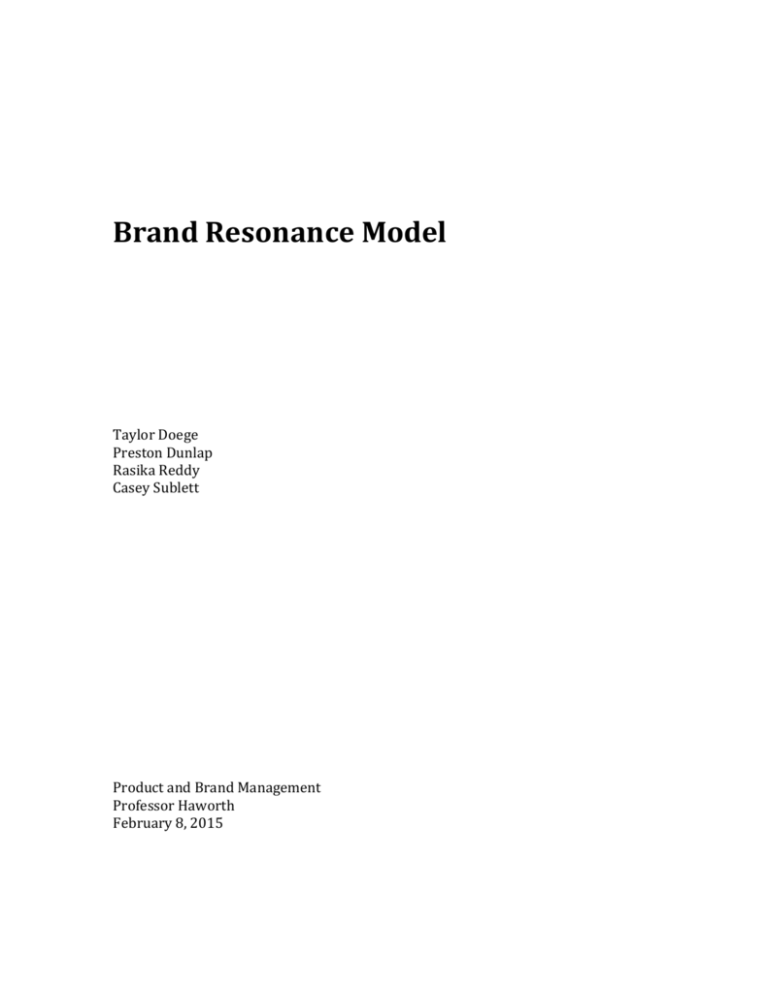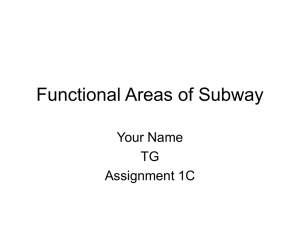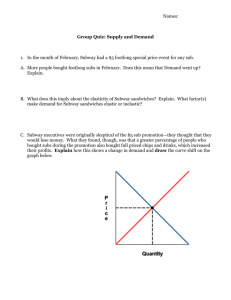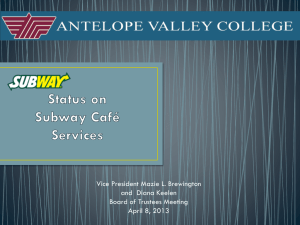Here - Taylor doege
advertisement

Brand Resonance Model Taylor Doege Preston Dunlap Rasika Reddy Casey Sublett Product and Brand Management Professor Haworth February 8, 2015 2 Table of Contents Executive Summary…………………………………………………................................. 3 Background……………………………………………………………………………………... 4 Analysis Who are you: Salience…………………………………………………………… 5 What are you: Performance & Imagery………………………………….. 6 Imagery………………………………………………………………………………………. 7 What do I think about you: Judgment……………………………………………. 8 Feelings……………………………………………………………………………………… 9 Resonance…………………………………………………………………………………... 10 Recommendations…………………………………………………………………………… 11 3 Executive Summary Subway and Jimmy John's -- two competitors in the same market, yet two very different brands. Subway is the largest and one of the most successful food-chains in the world. They have established a healthy and fresh alternative to what we see as "fatty American fast food". Consumers love having what they perceive as a better option and loyalty to the brand has been established for decades. However, there is something Subway does not do: delivery. This is where Jimmy John's has capitalized on the weakness of its competition and specialized in convenience. Both companies are targeting a specific consumer. Of course the bigger a company is, most likely, the bigger the brand is and this definitely rings true for Subway. The amount of brand equity Subway has is unsurpassed (besides McDonald's perhaps) and thus their Brand has a lot of good things going for it. For instance, it is easy to determine that Subway is all about customization. However, it is not exactly fair to judge Jimmy John's under the same standards since they are so small in comparison. Even though they aren't nearly as large, Jimmy John's fast service and convenience has helped build their brand equity and image. Jimmy John’s image is all about fresh sandwiches, cold cuts, premium ingredients, and of course freaky fast delivery. A brand’s image is possibly one of the most key things it possesses, and is one of the largest shares of a brand’s equity. Subway and Jimmy John's have defined who they are, what they are, how they want to be thought about. The aspects that go into each brand's equity are salience, imagery, performance, judgments, feelings, and resonance -- but the true test of a brand is how effectively it puts together all 6 of those aspects. This is what we aim to define in the following words for both Subway and Jimmy John's and see what they excel at and where they fall short. 4 Background Imagine this: “Hey guys let’s get delivery for the game, what are the options?” Pizza Hut, Dominoes, Jimmy Johns are probably the most accessible that come to mind in terms of takeout. Sure there is Chinese delivery, but for the football game it just doesn’t seem right. Besides, the game starts in 10 minutes and is pizza really going to make it in time – or will they interrupt during the game causing you to miss the biggest play of the year? Lets get Jimmy Johns. Here is a different scenario: “Mommy, I’m hungry.” “What do you want to eat?” “A sandwich.” Now there are a few choices, such as Potbellies, Jersey Mikes, and Jimmy Johns, but more than likely, nothing comes to mind faster than subway. In this scenario we have a mother daughter, and Subway just seems healthier and more personable right? This is what companies strive for. They want to be at the forefront of the minds of consumers whenever they are in a certain state of mind. Notice above how two different scenarios led to the same food choice, sandwiches, even though they were completely different sets of people. How do these brands obtain this level of accessibility in our minds? They do it through brand resonance. Brand resonance is the thoughts and feelings consumers associate with your product. If a sandwich shop opened up and the sign said “SANDWICHES” then sandwiches are expected, but what about them? Are they healthy, are they the best, are they unique, do they deliver, what different options do they have, what should s consumer expect from a shop that has a sign that simply says “SANDWICHES”? While it very well could be a hole in the wall star as some eateries are, it could also be Joe in the back handing out bologna and mayonnaise sandwiches all day and the only variety is whether you get pickles on the side or not. There is nothing associated with “SANDWICHES” therefore the consumer won’t feel anything about the shop and it wouldn’t come to mind when they want a sandwich. To achieve brand resonance such as Subway and Jimmy Johns has, there are building blocks to follow, which are laid out before us by Kevin Keller, a marketing professor at Tuck School of Business at Dartmouth, and his brand equity model. While the model is simple, achieving brand resonance requires work. There are two roads up the pyramid that must be followed simultaneously. To achieve brand resonance the first step is brand salience – who are you? The second is performance and imagery – what are you? After you establish what you are you must answer what about you – what judgments and feelings will people get about the brand. Finally brand resonance is achieved –what about you and the brand. To exemplify Keller’s model, this study will examine two sandwich shops, Subway and Jimmy John’s, and their brands to demonstrate the different routes taken by two products that share the same product, but use their branding strategy to introduce points of parity to make them differentiable. 5 Who are you? Brand Salience Salience is about category identification and needs satisfaction. Both brands, Jimmy John’s and Subway, offer sandwiches. What makes them fundamentally different then? Why not toss a coin and decide where to go by that? This is the simple parity between the two brands as to what they offer. Subway satisfies the need for a sandwich. However it is not just a simple sandwich, it’s something that can be customized. Subway offers sandwiches that can be made with ingredients that might not be so readily available. Their menu is guidelines for sandwiches that work, but you could very well go in and completely make something of your own creation. From their website Subway describes its core model as, “As we continue to grow, we are guided by his [Fred DeLuca – co-founder] passion for delighting customers by serving fresh, delicious, made-to-order sandwiches“ (Subway) and emphasizes who they are targeting as a consumer base: “We’ve become the leading choice for people seeking quick, nutritious meals that the whole family can enjoy” (Subway). This basic salience of the Subway brand allows people to know that at Subway they will get a customized, hand made, healthy, fast sandwich at a low cost. Jimmy John’s also satisfies the needs for a sandwich. However, Jimmy John’s does something subway doesn’t – they deliver. Jimmy Johns has built his brand on fast delivery and fresh ingredients. The sign says “Jimmy John’s gourmet sandwiches”. Ingredients are a point of pride for the company as taken from their website: “What makes Jimmy John's different from the rest is that it's honest, it's damn good, it's damn fast, at a decent price! Jimmy John's definition of fresh is worlds apart from everyone else's. Bread is baked in-house everyday and served fresh. Meat and veggies are sliced fresh in-house everyday. The turkey is real turkey, the roast beef is real roast beef – no additives, no vegetable-based fillers, no fake stuff. Nothing is delivered pre-sliced. Real Hellmann's mayo, real Grey Poupon, real olive oil and red wine vinegar – it's the best of the best.” –Jimmy Johns Jimmy John’s salience relies on a consumer base that wants fresh sandwiches, cold cuts, premium ingredients, and of course freaky fast delivery. After brands have agreed upon who they are, and they get the word out to the consumer, how do they differentiate? What does Subway stand for that Jimmy John’s doesn’t and vise versa? This is how we get to the performance and imagery of a brand. 6 What are you? To answer the question “what are you?” a brand must figure out two things: what type of performance will people expect from the brand, and what type of image the brand will present. Successful marketing of the brand will result in a clear and recallable description of what the brand does and why it does it. Performance Performance describes how your brand meets your customers’ physical needs. Subway has done amazing with sandwiches, but has also grown in terms of product selections. They now offer: the classic hot and cold sandwiches as well as soups, salads, pizzas, and flatbreads. With those product expansions carrying the Subway name people expect a certain standard of quality with the products, but they also inherently trust them since they already trust in the Subway brand name. Another aspect Subway has focused on heavily is its price point. Many people would not consider Subway unaffordable, even in financial hardships. Their five-dollar foot long deal is instantly recognizable by many, mostly in part due to the commercial blockbuster that was their five dollar foot long jingle which is still stuck in the head of the masses. Another key factor to Subway’s success was its ability to franchise. The Subway franchise is much easier to afford than most other fast food chain franchises – leading to their domination of the global market: there are 43,540 restaurants in 110 countries worldwide, the most of any food store in the world (Subway). Subway has made its store and brand more accessible than ever through these franchises. Jimmy John’s focuses on a different performance standard. Their performance model offers less sandwich options, however they have the ever-important delivery. In the modern age of instantaneous internet, texts, transactions, and communications the value of fast is becoming ever more critical. Consumers can expect a performance from Jimmy John’s that will deliver them a fresh, gourmet sandwich with a minimal amount of waiting. The brand is centered to be cheap but is still a bit pricier when compared to Subway. The Jimmy John’s brand is widespread and franchised, though not nearly as much as Subway, with 2000 stores nationwide (Jimmy John’s). However with the store coming second to delivery, the service is not as personable compared to the Subway stores, where sandwiches are built with you right there for every step of the process. Besides performance, one other characteristic provides an answer to what are you – and that is image. A brand’s image is possibly one of the most key things it possesses, and is one of the largest shares of a brand’s equity. 7 Imagery Imagery refers to how well a brand meets consumers’ intangible needs – their social and psychological needs. Imagery leads to what is associated with the brand, and how consumers will eventually feel about the brand. Subway has three main points of imagery associated with the brand. When people think of Subway, the three most prominent images associated with the brand are: Jared from Subway, their slogan Eat Fresh, and the five-dollar foot long commercial that was mentioned in the previous section. Jared, their company “mascot”, was an average Subway guest who vowed to get into shape on a subway diet. Eventually he did, losing over 200 pounds through subway products. This imagery is important because it promotes the companies strive for a healthy image. Their slogan, “Eat Fresh”, is another health conscious image that also doubles for quality of the product. By eating fresh, not only are consumers getting a superiorly fresh product – the freshest bread, produce, and meats – but they are also making a health conscious choice that might not be associated with store bought produce or deli meats. And of course, the famous five-dollar foot long. Subways affordability has taken off ever since the five-dollar foot long campaign was conjured up by a Miami franchisee. Even with most of their “premium subs” costing a bit over six dollars, the five-dollar foot long campaign, which had changed the entire pricing structure of the company, continues strong years later. Subway will always be considered affordable because of the breadth of people the five-dollar foot long campaign reached. Jimmy John’s is interesting for imagery. There are not many television commercials, if any, and the slogan is not as readily available as Subways. “Freaky Fast” is the slogan for Jimmy John’s which again only highlights the delivery aspect of the brand. Only radio commercials have really given the brand any personable identity with its fast narrator telling stories of fast delivery. The brand is not as recognizable compared to Subway’s and really is centered on a younger market than Subway is. After a brands performance expectations and imagery associations are set, they must focus on what the consumers feel and think about the brand choices that were made. The consumers’ reactions to how a brand presents itself is a key definer in whether the brand will be successful as is or not. 8 What do I think, or feel, about you? To answer this question, a brand must understand two consumer responses: what kind of judgments will potential consumers have about the brand, and what type of feelings does the brand evoke? Successful marketing of the brand will more than likely result in the preferred responses from consumers. This level is known as a more transitional phase because it bridges the gap between the feature and resonance levels. Judgments and feelings reflect the effectiveness of your performance and imagery. Judgments Judgment refers to the responses from consumers about a particular brand and what they perceive as its quality, credibility, relevance, and superiority. Consumers constantly make judgments about a brand and therefore the company must keep this in mind to be successful. Our main judgments on Subway reflected a positive performance and delivery of an exceptional quality service. The first judgment we came up with was great value. We believe that this spoke to the consideration aspect of judgment and providing value was relevant to the needs of customers. The $5 footlong specials they run on a regular basis meet the needs of consumer value -- you get a ton of "bang for your buck" -- 12 inches of sandwich for an incredibly reasonable price. Now, not only do you get a great value with Subway's sandwiches, but you get healthy choices and alternatives (our next judgment). Subway's multitude of products is both high quality and superior to its competitors with a plethora of health conscious options -which is increasingly important in today's ever-growing "health nut" society. Along with this, Subway is incredibly innovative which speaks to its credibility, likability, and consideration of consumer needs. $2 specials on 6 inch subs for customer appreciation month, reminds the consumer that we are valued and that Subway is still relevant in our lives -- and we should keep going back. We also judged that Subway is superior to its competitors. They have all kinds of options, from hot sandwiches like there incredibly popular meatball sub, to cold cuts on flatbread. The choices are endless, and to top it off, you can have this freedom of choice in almost every country around the world. Subway's international reach is unmatched. Now, Jimmy John's was a little bit different for us. We did not necessarily judge JJ's as worse than subway, but that they had a little less of a desirable range of products with less accessibility. For example, for pretty much the same product of what you could get at Subway, you pay almost double the price at JJ's. Although it's differentiated, we do not want to pay more for what we perceive as an equal product. However, Jimmy John's has capitalized on a niche market -- delivery. This consideration meets many consumers need of having sandwiches come to them and they are unique because of this. Jimmy John's is convenient and a quick solution for those times when you just can't go to Subway or are craving something different. 9 Feelings Feelings is the second part of the consumer response level and represents the emotional response a consumer feels when they think of a brand. Feelings is a slight bit different from judgments in that feelings are a pure emotional response to stimuli (in this case a brand) while judgment is the ability to come to a sensible conclusion. In other words, feelings are emotions and judgments are interpretations of a brand. Examples of emotions are warmth, fun, excitement, security, social Approval, and self-respect, but obviously this is not a completely exhaustive list. Subway has paved its brand and established their priorities as a corporation. They aim to be healthy, affordable, and consistent. The feelings we came up with first are fresh and guilt-free. Subway makes you feel good inside and out. It is this way most likely, because they push for healthy options and are transparent with their ingredients -- and you get to choose these ingredients. The guilt-free feeling comes with the entire experience, not just saving calories. The fact that their prices are so cheap and you could feed an entire family for around $20 or less, make it easy on your wallet as well. Guilt-free all around. Some of our other feelings associated with Subway were freedom (mostly of choice) and consistent satisfaction. Most people enjoy how much freedom they have with their ingredients and that they can add fresh vegetables or whatever they please. Jimmy John's does not have nearly as much freedom. You tell them the sandwich you want, and it's made for you with only a couple of options like adding mayo, mustard or hot peppers. Plus, Subway has done a great job of making every Subway consistently taste the same. With this consistency, you always know what you are going to get. The positive feelings we got from Jimmy John's was instant-gratification and a "homemade" feeling. What Jimmy Johns excels at is fast service and delivery. If you want something quick or don't want to go to Subway, Jimmy John's has the service for you. Of course, not all people feel this way, but everyone we have talked to in and outside our group came to this consensus. Subway is usually the first choice, but regardless, Jimmy John's still has some things going for it. One feeling we had that was interesting is that "Jimmy John's feels like something you would make at home, just 10 times better". While it was not the first feeling that came to mind, there is definitely a homemade feeling that is evoked by Jimmy Johns. 10 "How much of a connection would I like to have with you?" Brand Resonance is the very top of the branding pyramid because it is the most desirable yet most difficult level to achieve. Resonance is the deep bond a consumer has with a brand and this leads to loyalty, attachment, community, and engagement. Brand resonance does not usually come easily, but more established companies strive for excellence in this category by tackling the other branding requirements in the pyramid and creating a sense of connection with their consumers on a psychological level. Creating relationships and deep connections leads to more satisfaction and loyalty to the brand, thus creating more sales. Resonance Subway has quite a bit of resonance in today's society. The very lowest level of resonance is repeat purchases. Subway has so many storefronts and convenient locations. Combine that with an exceptional product and you get behavioral loyalty. Even one of our group members said that on road trips around the United States, she would specifically wait for a Subway, because she knew one would come up soon and she preferred the food to anything else. It's hard to imagine that we are so loyal to a sub sandwich shop like Subway, but from almost everyone we have talked to, it's hard for them to say that they are not loyal to the brand (when they think about it). Also, the "Eat Fresh" campaign has created a lot of attitudinal attachment. Customers love that they are getting a healthy option and it feels like a special purchase to them because they can "save calories" while eating something they thoroughly enjoy. Furthermore, NASCAR has also been a big sponsorship partner that has established community and the Healthy Community with the Jared Foundation has fostered active engagements between the consumers and the brand. Jimmy John's has not quite reached the level of resonance yet. Consumers do not feel a deep, psychological bond with the Jimmy John's brand and thus attachment, community, and engagement are not as solid as they could be. This is where Jimmy John's needs to act. We do believe that Jimmy John's has behavioral loyalty because many customers have repeat purchases either in store or delivery. If Jimmy johns can develop an attitudinal attachment by making the purchase feel special, creating community by making the brand something that is relatable, and actively engage the community through marketing rallies or goodwill events, they could boost their brand resonance. 11 Recommendations Taking all of the previous branding aspects into consideration, our group has some recommendations for both Subway and Jimmy John's. Subway should start to improve its upper resonance levels, more specifically it's engagement with the community. We would like to see more visible community events or philanthropic sponsorships in order to give us a better idea what their values are and to be a part of society with customers. When we think of a brand that has great engagement, we think of Coke and all of their clever marketing campaigns. Now, we know that Subway is capable of doing this (and are most likely attempting something for engagement), but they need to figure out a way to really engage those yearning for something more. We want to see Subway help our society and spread goodwill so we can have even more of a reason to keep purchasing sandwiches. For Jimmy John's, they need to focus on what they have been developing already. They need to "own" the brand and start to branch out with their marketing efforts. Their slogan right now is "Freaky Fast Delivery" and this has the potential to be great for them. The only sponsorships they have are with auto-racing teams and organizations, but we do not feel this is enough to establish their brand and to convert more customers. Whenever we walk into a Jimmy john's we don't really understand what it's trying to achieve for its image, and his needs to be fixed by solidifying who they are and what they plan on being. Jimmy John's also needs to widen their product offerings. It's great to have a simple concept and menu, but some people don't like that they only have 9 or 10 options to choose from. This feels like you do not have the freedom of choice -- and looking at Subway, they don't have that many more sandwiches than Jimmy John's, but they let you choose what goes in them, so it seems like they have an infinite amount of sandwich combinations which keeps things fresh and exciting.





